|
Gateway to the Mountains
George Wireman
Chapter 15: Western Maryland Railway Company
The Western Maryland Railway Company, originally chartered as the Baltimore, Carroll and Frederick Railroad Company in 1852,
was projected with the idea of recapturing the trade of the Cumber-land Valley, which centered in Hagerstown and was being diverted toward Philadelphia. For
many years prior to the incorporation of the Baltimore, Carroll and Frederick Railroad, the people of Baltimore were anxious to establish communication by rail
with the fertile territories of Westminster, Union Bridge and Hagerstown.
The Baltimore and Susquehanna Railroad, later acquired by the Northern Central, was incorporated February 13, 1828 and a short
time later had completed eight miles of its main line from Baltimore to Relay House, now Lake Roland. Work on the main stem was then stopped and the unexpended
portion of the original capital was then devoted to the building of a branch in the direction of Westminster, with the ultimate purpose of extending it to the
headwaters of the Monocacy River, as authorized by a supplement to the charter passed on February 7, 1830. Nine miles of road were built through the Green
Spring Valley from Relay Station to Green Spring Hotel in the vicinity of what is now Owings Mills. When work was resumed on the main stem from Relay Station,
nothing further was done on the extension of the branch towards Westminster for twenty years.
On April 7, 1847, the citizens of Carroll County assembled in the Court House in Westminster and took under consideration the
propriety of extending a railroad through the county. At this meeting a committee of eleven was appointed to correspond with the president of the Baltimore and
Susquehanna Railroad, and to urge the necessity of a railroad into Carroll County.
However, nothing was done by the Baltimore and Susquehanna in the way of extending their branch, and on November 16, 1850 a
town meeting was held at Westminster for the purpose of devising ways and means of connecting the Baltimore and Susquehanna road with some point in the interior
of Carroll County.
On December 2, 1850, a large and enthusiastic meeting was held to further the project of building the proposed railroad and
Robert M. Magraw, president of the newly formed Baltimore, Carroll and Frederick Railroad, presented abundant facts to prove the importance of the road.
Subscriptions were taken and four routes were pro-posed: the first from Cockeysville to Ely's Mill; the second from Love's Switch to Black Rock; the third from
Cockeysville to Hampstead; and the fourth from Owings Mills through Reisterstown, Ely's Mill and up the falls to Westminster.
These meetings culminated in the incorporation of the Baltimore, Carroll and Frederick Railroad on May 27, 1852, with a charter
that authorized it to build a railroad from the terminus of the Green Spring Branch of the Baltimore and Susquehanna to the headwaters of the Monocacy River,
presumably at Rocky Ridge or Mechanics-town.
Col. John K. Longwell of Westminster, who was very closely identified with the early development of Carroll County, both in
political and financial ways, was the author of the charter, and secured its passage by the State Legislature. He also served on the first Board of Directors of
the newly organized company, with the following men as incorporators:
- John Cover
- Joshua Smith
- John Baker
- Samuel Ecker
- David Roop
- Joseph Moore
- John Smith
- Richard Green
- J. Henry Hoppe
- Charles Painter
- Robert M. Magraw
- Edward Remington
- Jacob Reese
- Joshua Motter
- John Fisher
- Jacob Mathias
- George Brown
- Nicholas Kelly
- Zenus Barnum
- David Rinehart
- Robert Annan
- Jervis Spencer
- Isaac Motter
- Daniel P. Saylor
- David H. Shriver
- Peregrine Fitzhugh
- William F. Johnson
- Richard Worthington
- Reuben Haines
To anyone familiar with the history of Carroll County, these names show that in its conception, the Baltimore, Carroll and
Fredcrick Railroad was a Carroll County enterprise, the inhabitants of that section subscribing for nearly all of the original stock of the company.
By special Act of the Legislature of Maryland on March 21, 1853, the name of the Baltimore, Carroll and Frederick Railroad was
changed to Western Maryland Railroad Company. At this time the Legislature also passed an Act authorizing the company to issue bonds and to extend the road west
to Hagerstown, Maryland.
On August 11, 1859, the road was opened to Owings Mills. The first excursion out from the city was described in the "Baltimore
Clipper" and dinner was served at the Green Springs Hotel, a famous hostelry at that time. Such solid Baltimoreans as Hugh Carlston, Col. Samuel Thompson and
Alexander Murdock, presided at the tables, and the Hon. John E. Smith of Carroll County made a speech "sparkling with eloquence and poetry" in which he foretold
how the railroad would enable the "mountains to kiss the sea."
In July, 1861, the road was opened into Westminster, and the construction was continued in a westwardly direction until in the
month of November, 1862, Union Bridge was reached.
Travel from Westminster to Baltimore was unique in those early days. The engine fuel was common firewood. Along the Patapsco
Falls the train would come to a halt to take on a supply of wood. The conductor, the brakeman, and most of the male passengers would get off and help fill up
the tender with wood which had been sawed into proper lengths by a man with a saw and buck.
Union Bridge remained the terminus of the railroad until January 9, 1871, when the road was opened for operation into
Mechanicstown.
The Western Maryland Railroad has since played an important part in the history of this community, for after the line was
extended to Sabillasville in 1871 and on to Hagerstown in 1872, it gave fresh impetus to the business of the town. Express connections were soon established and
telegraph wires were erected.
|
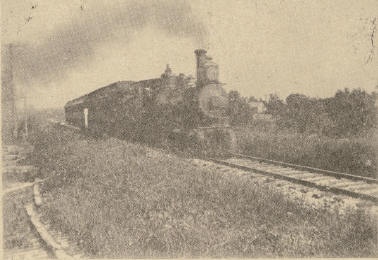
Early Western Maryland train as it passes through Graceham, Md.
|
Upon the event of the coming of the railroad to Mechanicstown, a group of civic-minded citizens arranged a reception and a
banquet for the railroad officials and their guests. This event took place in the local warehouse and a gala celebration was enjoyed by all who attended.
Temporary quarters were set up at the warehouse for the telegrapher while more permanent facilities could be established. The
first depot was located on the site of the old cannery. A water tank was erected just north of the station, and the water was piped in from a reservoir which
was supplied by a near-by spring. A freight yard was located just east of the main track and was bordered by a service track for carload shippings and a Wye
track used for turning the locomotives. Within this area the operator's office was located which proved to be nothing more than a discarded show car.
An engine house stood in the center of the area, and the spur end of the Wye was supported by bins which were used for coal,
coke and limestone for the Catoctin Iron Works. The first operator of the station was William A. Hahn and the stationmaster was Harry Shriner.
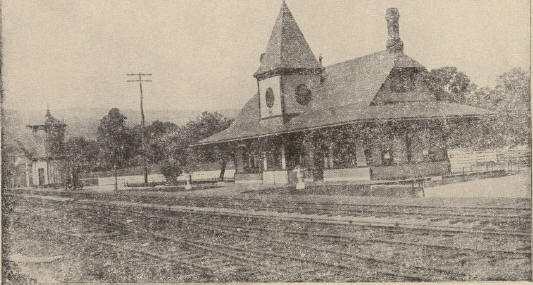
Western Maryland Railroad Station as it looked around 1910
Increased operation necessitated the building of additional facilities, and making a number of improvements. The new depot was
built along the main line near Carroll Street and featured two waiting rooms, stationmaster and telegrapher's office and sanitary facilities. The grounds were
graced with four large grass plots, one on the east, one on the west side of the station and two in front. These plots were beautified with ornamental grass and
flowers protected by low guard rails. The front plots had large lawn vases in the center with blooming flowers.
Two water tanks were erected, one at each end of the station. A freight house was constructed just east of the station and a
carpenter shop was located in the rear. With these facilities the depot was operated successfully for many years. Eventually increased business necessitated
many changes and in time all the structures and materials were moved. Nothing remained but the station building it-self.
|
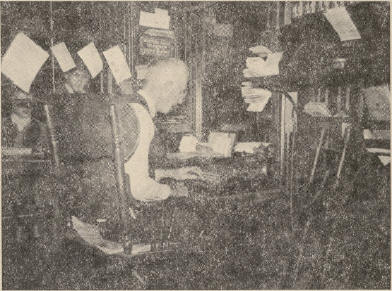
Telegrapher, H. T. Lawrence at work
|
Stationmasters and telegraphers of the local station were Harry Shriner, Frank Hesson, Stanley R. Damuth, William I. Renner,
Harry W. Ruch, William Saltzgaver, William A. Hahn, Cover Morrison, Wm. F. Harbaugh, Theodore Lawrence, Howard E. Danner, S. Elmer Barnhart, and others.
In this connection one should speak of the electrical crossing bell, now universally used, invented by Richard J. O'Toole, one
of the town's best mechanics and inventors. He maintained a shop on
Boundry Avenue and was employed by the railroad when he developed the bell. A stock company was soon formed and the plant was
moved to Baltimore since the persons having controlling interest in the company lived there. Mr. O'Toole's financial share in the invention was a total loss,
but the warning signal bell still re-mains a memorial to his genius.
In 1894, when John M. Hood was President of the Western Mary-land Railroad, and because of the confusion resulting from the
multiplicity of towns having the same names such as Mechanicstown, Mechanicsville, Mechanicsburg, etc., it was found necessary to change the name of the local
station. The name of the town was changed at the same time and the selection of a new name was left to the citizens. After much discussion and the consideration
of many suggestions, the name of the town was changed to THURMONT, a significant name indeed, for THURMONT means, "Gateway to the Mountains." This name was
suggested by Charles E. Cassell, then Editor of the town's newspaper, "The Catoctin Clarion."
On Saturday, June 17, 1905, Ransom, Maryland was the scene of one of the worst wrecks in the history of the Western Maryland
Railway, claiming the lives of 26 and injuring about 11 others. The tragedy of this wreck was that 16 of those who were killed were from Thurmont and Catoctin.
These victims were hard-working, industrious men, fathers and sons, wage-earners and the main support of, in many instances, large families.
All that is really known of the wreck's cause is that the engineers of the two engines of the west-bound freight train, both of
whom were killed, knowing that they had to wait for the passing of three trains, pulled out of the siding at Gorsuch after only two trains had gone by, and
traveled only four miles when they collided with the third train at Ransom, just about a half mile above Patapsco Station.
Of the crew of nine men aboard the freight train, three barely escaped with their lives. These were George T. Lynch, flagman;
O. R. Nyman, brakeman, and H. W. Berger, who was on the train as a learner.
The testimony of all three as to the manner in which they came to leave the siding before the third train was due, is
practically the same. Flagman, George Lynch told the following story which was taken from the June 22, 1905 issue of the Catoctin Clarion, which covered the
wreck in great detail.
"We got into the siding at Gorsuch about 4:25 P.M. and waited there considerably more than an hour. While we were waiting we
got down from the train and sat on a pile of ties near the track. The two engineers and the conductors had their time cards and schedules and we talked for a
while about the time we were making, and how long we had to wait for No. 5 (the third train) and where we would run to after she passed.
"No. 17, the Union Bridge Accommodation, came past on time and then No. 11, the Blue Mountain Express, which was making her
first trip of the season, followed. We talked about what a fine train she was, and, so far as I know, there wasn't any misunderstanding about No. 5. We had seen
the two trains pass and were waiting for the regular.
"I took a bucket and went to a spring nearby to get some water. When I got back to the track, the engineer was in his cab and
the train was pulling out. They called to me to jump aboard if I was going, and 1 did. I then looked at my watch and saw that No. 5 was not due for another few
minutes. I yelled out to the fireman ahead: `Where are you fellows going to pass No. 5?' He yelled back as near as I could catch it, `At Lawndale.'
"Again I looked at my watch, and when I saw the time I shouted, 'For God's sake, look at your watch.' He waved his hand at me
and I could only think that it was my watch that was wrong. There were the two engineers, the two conductors and the fireman, five in all, who had the time and
knew the schedules as well as I did.
"For a minute or so I thought of putting down the airbrakes, but I thought again that I must be wrong and that five men could
not be mistaken."
It was at Ransom that the two freight trains met No. 5 head-on, killing 26 persons and injuring 11 others.
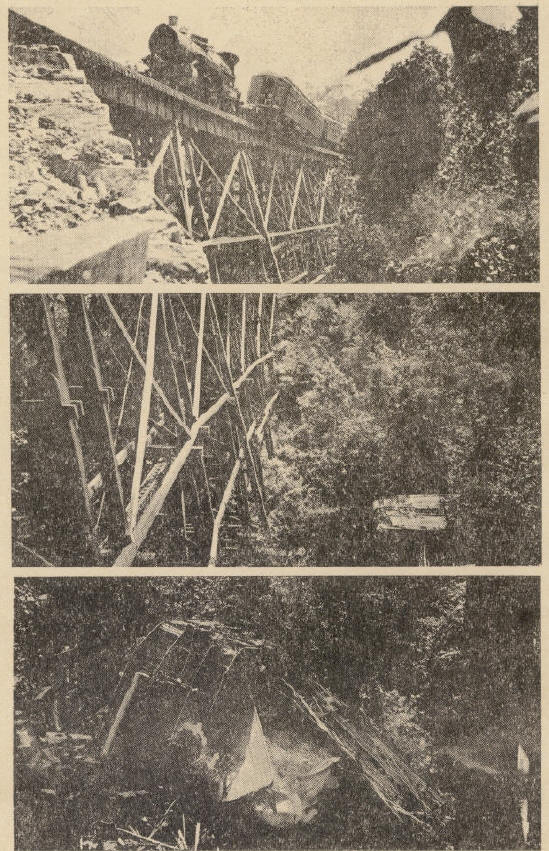
Thurmont felt the effects of the wreck more than any other community. A list of the dead from this area, as published in the
Catoctin Clarion was as follows: George Stimmel, Elmer Miller, Nelson Fraley, John Williard, Edward Martin, Charles Grable, C. Brenner, all of Thurmont.
From Catoctin there was M. Sweeney, W. T. Sweeney, Frank Sweeney, Harry Sweeney, C. Kelly, J. M. Shuff, James Grushon, Joseph
Stitely and James Benner.
The scenes at the Western Maryland depot in Thurmont were such as were never before witnessed by the citizens of the community.
The report of a wreck on the railroad at once created great anxiety and the next report was that 40 to 60 persons were killed or wounded, most of them from this
locality. This created an unusual amount of excitement; in an hour after the report was received, about 500 people were at the station.
All day on Sunday, June 18, crowds of people could be seen going to the station expecting to hear news of their friends. A
re-port went forth that at 7:00 P.M. a train would arrive with the dead. Undertakers Clarence Creeger and Elmer Black were on hand with hearses and carriages in
which to convey the dead to their respective homes.
Sixteen funerals were held in two days and heart-breaking scenes were witnessed.
|
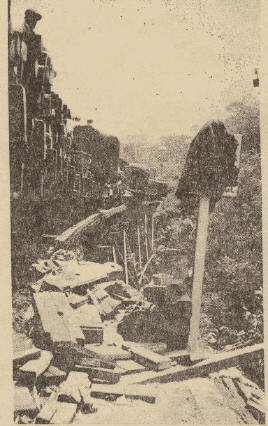
Wreck Scene At High Bridge
|
The situation at Catoctin was most pitiful. McClellan Sweeney and his two sons, Frank and William were killed in the wreck and
left a wife and six children. Charles Grable, a wife and seven children; John Williard, a wife and five children; Joseph Stitely, a wife and four children;
James Grushon, a wife and three children; Charles Kelly, wife and three children; Elmer Miller, wife and two children; James Benner, wife and one child; Edwin
Martin, wife and one child. William Shuff, Nelson Fraley and George Stimmel each left a wife and Calvin Brenner and Harry Sweeney were unmarried.
From this list it can be seen that there were 38 fatherless children because of the wreck and the sympathy of the community was
wide spread for these poor people who were left to battle life for them-selves and children single-handed.
In respect of the dead, all business places in Thurmont were closed on Monday afternoon following the wreck, during which time
most of the funerals were held.
The wreck will long be remembered by many citizens of the community, some of which are still living and can recall the effects
this shocking disaster had upon this community.
The Western Maryland Railway is actually not one road but many, through consolidations, mergers and reorganizations it is the
outgrowth of more than 30 railroads. It probably is the only railroad in the country to produce a president who would be memorialized in bronze by a grateful
municipality. At one time the company boasted it was the only road carrying sightseers to the two great battlefields of the Civil War — Antietam and Gettysburg.
Although it was primarily a freight line, the Western Maryland be-came famous for the excursion trains it ran to the Blue Ridge, and for the Blue Mountain
Express, said to have been the finest train in the East.
On June 25, 1915, the famous Blue Mountain Express met a mail train from Hagerstown in a head-on crash on High Bridge just west
of Thurmont, killing six persons and injuring several others. Fifty-two years have passed since this wreck, but there are a number of local citizens still
living that recall this wreck and its effect on the community. One of these is Charles W. Eyler who was only 17 years old at the time. His account of the wreck
follows:
"I was 17 years old at the time, and had a paper route in town with a friend, Earl Rout, now of Biglerville. We would meet
the Western Maryland's Blue Mountain Express every afternoon about 5:10, get the Baltimore papers from the baggagemen and deliver them before supper.
The express, known to the railroad and the townspeople as No. 11, was a crack passenger train, rarely off schedule. On the
afternoon of June 25, however, it was off. Earl and I waited around the station for twenty minutes and finally heard its whistle coming up the line.
It pulled in and we asked the fireman, Fred Hayes, what had happened. He said that they had had a hotbox which they had
repacked at Union Bridge. The one-legged baggageman, Luther Hall, was complaining that he would be late getting home to supper in Hagerstown.
Earl and I got our papers and walked around the engine toward town. Sometimes we waited until it had finished taking on water
and pulled out, but we were late ourselves and wanted to get the papers delivered. This afternoon the conductor would have to get new orders from Hagerstown,
telling him which siding to use to let the eastbound mail train pass. Much of the line through the mountains was single track.
We heard the train pull out from the station as we were al-most finished making our rounds, and about five minutes later we
heard the whistle blow again. But this time it didn't stop blowing, and we knew right away that something was wrong. We got rid of the rest of our papers in a
hurry and took off up the track, half running.
We had got almost to the bridge over Owens Creek, about two miles west of town, when we met the flagman running back down the
line. He told us the express had crashed head-on into the mail train right on the bridge, and that some people had been killed. A terrible sight met us when
we got to the bridge.
The two engines were locked together with their front sections telescoped. They must have met with a terrific impact. How
they stayed on the bridge, nobody could understand, but that surely prevented further loss of life. Coals were falling from one of the boilers and for a time
threatened to set fire to the wooden structure of the bridge. The whistle on one of the engines had stuck in an open position and kept blowing until all of
the steam was gone.
The wooden baggage car of the express was lying down in the ravine 100 feet below, completely smashed. The heavy steel
Pullman behind it had been thrown forward by the sudden stop, crushing both the baggage car and the engine's ten-der and knocking them off of the bridge. The
Pullman fell half off the bridge.
Most of the passengers had come out of the cars by the time we arrived and some were trying to help those trapped in the
wreckage in the ravine. Besides the baggageman, a Baltimore woman — Mrs. Edwin Chipchase — and her son had been riding in the baggage car. She was an invalid
and had to lie on a cot while she traveled, which is why she was not riding in the Pullman.
Also dead were Luther Hall, who had been worrying about being late for supper, and the fireman we had talked to at the
station. The engineer, Frank Snyder, had been thrown out on the locomotive's running board and had both legs broken.
Both the engineer and the fireman of No. 10, the mail train, were dead. The engineer, Coleman Cook, was from Baltimore. He
had been thrown down to the road under the bridge and killed instantly. Both engineers had been close friends and had seen many years of service with the
Western Maryland.
Six people died altogether, and twelve were injured. The first rescue parties arrived by car from Thurmont. We helped some of
the injured to neighboring homes, where they awaited transportation to the hospital in Hagerstown. Darkness was fast approaching and there was nothing anybody
could do for the people in the ravine."
It might be well to state here that so many people had gathered at the scene of the wreck that work of identifying the dead and
injured and locating those who were hurt was quite difficult. Dr. E. C. Kefauver, of Thurmont, the official physician of the Western Maryland at Thurmont was in
charge of the rescue work. Other doctors who assisted in the rescue work were Dr. Victor F. Cullen, Dr. C. L. Wachter, both of Sabillasville, and Dr. Morris A.
Birely of Thurmont.
In Mr. Eyler's account of the wreck he states:
"About 1000 people gathered, which was a lot for those days of scarce transportation. Earl and I stayed most of the night,
watching the crews at work. Their lights were not too good and they were afraid to pull the derailed Pullman off the bridge until morning. When the sun rose
they cleared the bridge except for the locomotives which were practically welded together by the impact.
People were still wondering the next day how the two engines had stayed on the rails. But it was easy to see how the wreck
had occurred. The bridge is "blind" from both directions. From the east, a train passes out of a deep, curving cut right onto the bridge. From the west, an
engineer had a little more visibility but was also on a curve and was traveling down-hill, making a quick stop impossible. There were no signals, and the
wreck was blamed on a mix-up of orders given out by the dispatcher in Hagerstown.
Wreckers cleared the line the next day, and in the mean-time trains were routed through Gettysburg over what was known as the
"Dutch Line." There was an investigation of the wreck about a week later in Hagerstown with representatives of the railroad and the ICC, at which time the
mix-up of orders was explained. The dispatcher, who was having some wire trouble shortly before making up the new train orders, took the blame.
He said that he had ordered the Highfield operator to have the mail train meet the Blue Mountain Express at a little siding
called Sixty-Mile Siding. The Thurmont operator, how-ever, was given orders for the Express to wait for the mail train at Flint Siding. The trains, strangely
enough, met just about halfway between these two points."
Mr. Eyler has often stated in his remarks about railroading, that the Western Maryland Railroad was for many years the
lifeblood of a community such as Thurmont. It brought food, milk, mail and newspapers and was the main contact with the rest of the world. At one time there
were twenty passenger trains a day, and the excursion runs from Baltimore to Pen Mar Park were taken by thou-sands of people each year.
A lot of people in the Thurmont area made their living by working on the railroad, and my father, George W. Wireman, Sr., was
one of them. I can recall hearing him say that during his employment with the Western Maryland, he helped to build and keep in repair, most of the bridges along
the line from Port Covington to Big Pool, west of Hagerstown. He worked with the carpenter gang which included such local names as John P. Style, Leonard J.
Flohr, J. Edward Baxter, Sr., Frank Dutterer, Grayson H. Fogle, Edward Baxter, Jr., J. Mack McGuigan, Alpheus Weller, Ollie Weller, William Harman and others.
On March 1, 1957, the Western Maryland Railway Company discontinued its passenger service which could no longer compete with
the automobile. The freight service continues to do a thriving business.
On Saturday, October 12, 1963, the local station resembled a scene from the pages of history when large crowds gathered to ride
the special excursions to Pen Mar Park, located a short distance west of Blue Ridge Summit in the beautiful Blue Ridge Mountains.
|
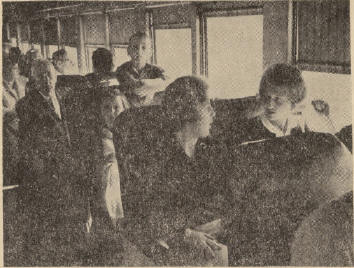
Local Citizens Enjoy a Ride on the Blue Mountain Express
|
Not since March 1957, when the last passenger train made its final run, had the local station been the scene of such excitement
and activity. The occasion of October 12, was the running of the Blue Mountain Express from Baltimore to Cumberland, by way of the Western Maryland through the
historic Blue Ridge Mountains. For miles around, citizens gathered with local residents, accompanied by their families and friends, to make the trip. For some,
it was their first train ride; for others it was a golden opportunity to relive pleasant memories of days gone by.
The excursion was sponsored by the Baltimore Chapter of the National Railway Historical Society and due to the heavy demand for
tickets, it became necessary to schedule two trains to accommodate everybody. The excursion was a complete sell-out and has been repeated each year since.
Although the excursion in 1963 was the second annual running of the Blue Mountain Express, it was the first time that passengers were picked up along the line.
Robert Hampson, a member of the Baltimore Chapter of NRHS, stated that this was the major factor contributing to the success of the excursion and why they have
been repeated each year.
On Friday, strange as it may seem, January 13, 1967, the local station of the Western Maryland Railway was closed after 95
years of service to the community.
An official of the railroad stated that the station was closed be-cause of "automation of accounting." The need for the station
diminished during recent years because of more modern accounting practices in Hagerstown have taken over the work of the Thurmont agency.
Thirteen days earlier, on January 1st, after 44 years of service with the Western Maryland, S. Elmer Barnhart, agent and
operator of the local station for 27 years, announced his retirement. Thus the end of operations at Thurmont. Mr. Barnhart stated that his retirement was
mandatory but the closing of the station was due to "progress."
What the future held for the local station was anybody's guess. Some thought that if enough interest was shown in this old
land-mark, the railroad might donate the building to the community for some worthwhile project as was the case at Blue Ridge Summit some years ago.
On April 4, 1967 the fate of the station was soon learned. A wrecking crew appeared upon the scene and began demolishing the
old landmark. Within the short period of three days, a stranger visiting the site would never have realized, that a railroad station once stood on this very
spot.
Although the Thurmont Chapter of the history of the Western Maryland Railway is closed, it will long be remembered by the
citizens of this community. It will be remembered as a history of a rail-road that was formed to connect a valley with a city, but grew up to become a strong,
important link in a system that today hauls the products and resources of a nation. One hundred and fifteen years ago it was just a dream of a few farmers,
merchants, millers and small town bankers and a weekly newspaper editor. One hundred and eight years ago it was a one-engine road operating, on thin ire); rails
imported from England, over a roadbed that not long before
had been used for horse-drawn cars. Seventy-three years ago it was responsible for changing the name of Mechanicstown to
Thurmont, meaning "Gateway to the Mountains," being in fact just at the opening of the pass through which the Western Maryland was built.
Today, powerful Diesels roar back and forth across the Alleghenies and the Blue Ridge with its trains. The heavy steel rails
stretch across the Maryland countryside into Pennsylvania and West Virginia. The road connects with seven trunk lines, and, at Port Covington, with the sea
traffic of the world. Yesterday the Western Maryland was still flexing its muscles. Today it is a road of brawn.
Chapter Index |
Chapter 16: Pen Mar Park
If you have any Information or historical news clippings on events in the
Thurmont Area, Please send them to us so we can included them in our archives. E-mail us at: history@mythurmont.net |